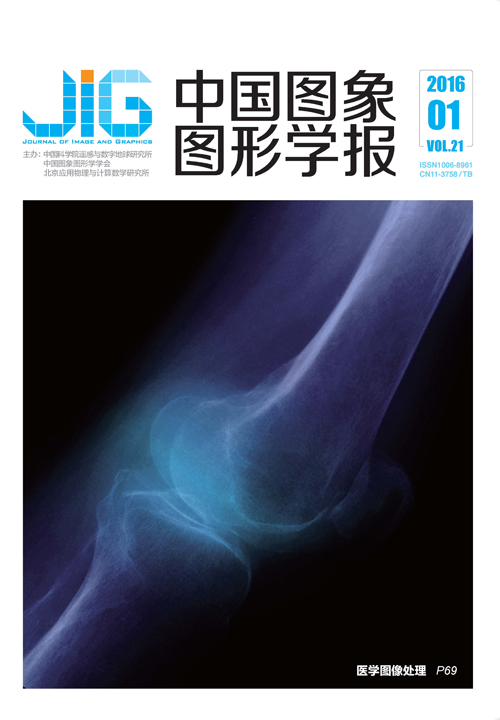
第二小方向导数信息熵的兴趣点检测
摘 要
目的 为了提高兴趣点检测的定位准确性和对噪声的鲁棒性,提出利用图像轮廓线及其邻域内像素点方向导数信息熵检测兴趣点的方法.方法 首先利用多方向Gabor虚部滤波器提取图像灰度变化信息得到第二小方向导数.然后利用Canny边缘检测器提取边缘映射,并填补断裂边缘映射提取边缘轮廓线.最后求解图像边缘轮廓线及其邻域内像素点对应的第二小方向导数所对应的信息熵归一化值并作为新的兴趣点测度.和直接由灰度变化信息及分析边缘轮廓形状或曲率提取兴趣点的方法相比,本文算法结合了两种算法的思想,利用轮廓线上及其邻域内的像素点梯度方向信息熵值作为兴趣点测度.同时不同于同质及边缘区域的梯度方向变化,兴趣点处的梯度方向变化信息呈现各向异性的特性,利用兴趣点第二小方向导数(第一小方向导数可能为零)对应的信息熵值作为新的兴趣点测度可提高算法的定位准确性.结果 通过对检测图像进行仿射变换和加入高斯噪声处理后,分别利用Harris算子、CSS算子、He&Yung算子和本文算法提取图像兴趣点,并比较各算法在仿射变换和高斯噪声情况下检测到的兴趣点的平均重复率和定位误差两个性能指标的平均值.其中本文算法的性能指标平均值为1.625,远高于Harris(3.25)、He&Yung(2.625)和CSS(2.5)三大兴趣点检测算子.结论 通过与典型的3种算法相对比,本文算法具有较好的平均重复率及噪声鲁棒性,尤其是图像在外界干扰的旋转变换和尺度变换下对兴趣点的定位性有着更好的检测性能.
关键词
Interest point detection by using information entropy of the second small direction derivative
Abstract
Objective This paper proposes a new interest point detection method by using contour shape and the direction derivative information entropy of surrounding pixels. The proposed method can improve localization accuracy and noise robustness. Method First, the multi-direction imaginary parts of Gabor filters are used to extract the gray variation information of input images to acquire the second small direction derivative. Scale multiplications are used as the measure to detect interest points. The proposed method is based on contour-based methods and is improved in two ways: the information of edge shape and the gray variation are combined to detect the interest points; the sensitivity of scale multiplication to local variation and noise on the edge contour is reduced. Second, the Canny edge detector is used to extract edge maps and fill gaps to obtain the edge contour. Third, the second small direction derivative information entropy of the edge contour pixel and its surrounding pixels is computed. The normalized entropy is used as new corner measure by comparing with the threshold. Finally, non-maximum suppression is applied to the result obtained in the third step. A local window (9×9) is used to slide through all the pixels of the edge contour. If the center pixel of the window is the local maxima within the window, the central pixel scale product is retained; otherwise, the center pixel will be set to zero. Result Compared with the gray method, which analyzes the contour shape, or the curvature-based method, the proposed method combines the idea of two algorithms that use the gradient direction entropy of the contour pixel and its neighbor pixels as the corner measure. Furthermore, unlike the gradient direction variation in homogeneous regions and edge lines, the information variation on the interest point presents an anisotropic feature. The information entropy according to the second small direction derivative (the first small direction derivative may be zero) is used as a new corner measure to improve localization accuracy. The proposed method has an average score of 1.625 in the performance index, which is significantly higher than the method of Harris (3.25) and He and Yung (2.625) and the CSS (2.5) interest point detection operator. Conclusion Compared with the three state-of-art algorithms, our approach is competitive with respect to the repetitive rate of interest point, detection accuracy, and noise robustness.
Keywords
interest point detection the imaginary parts of Gabor filters gray variation information second small gradient direction information entropy
|



 中国图象图形学报 │ 京ICP备05080539号-4 │ 本系统由
中国图象图形学报 │ 京ICP备05080539号-4 │ 本系统由